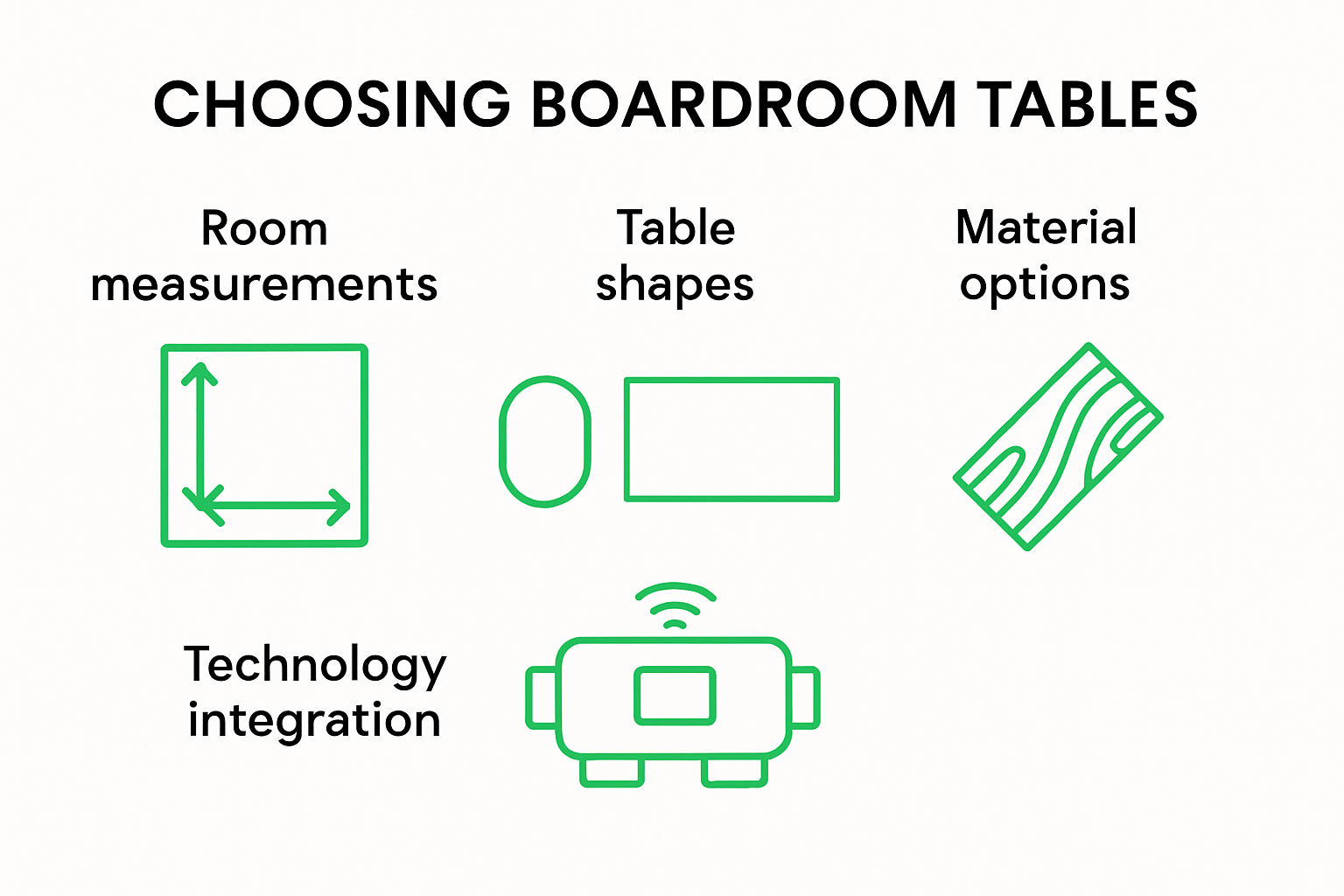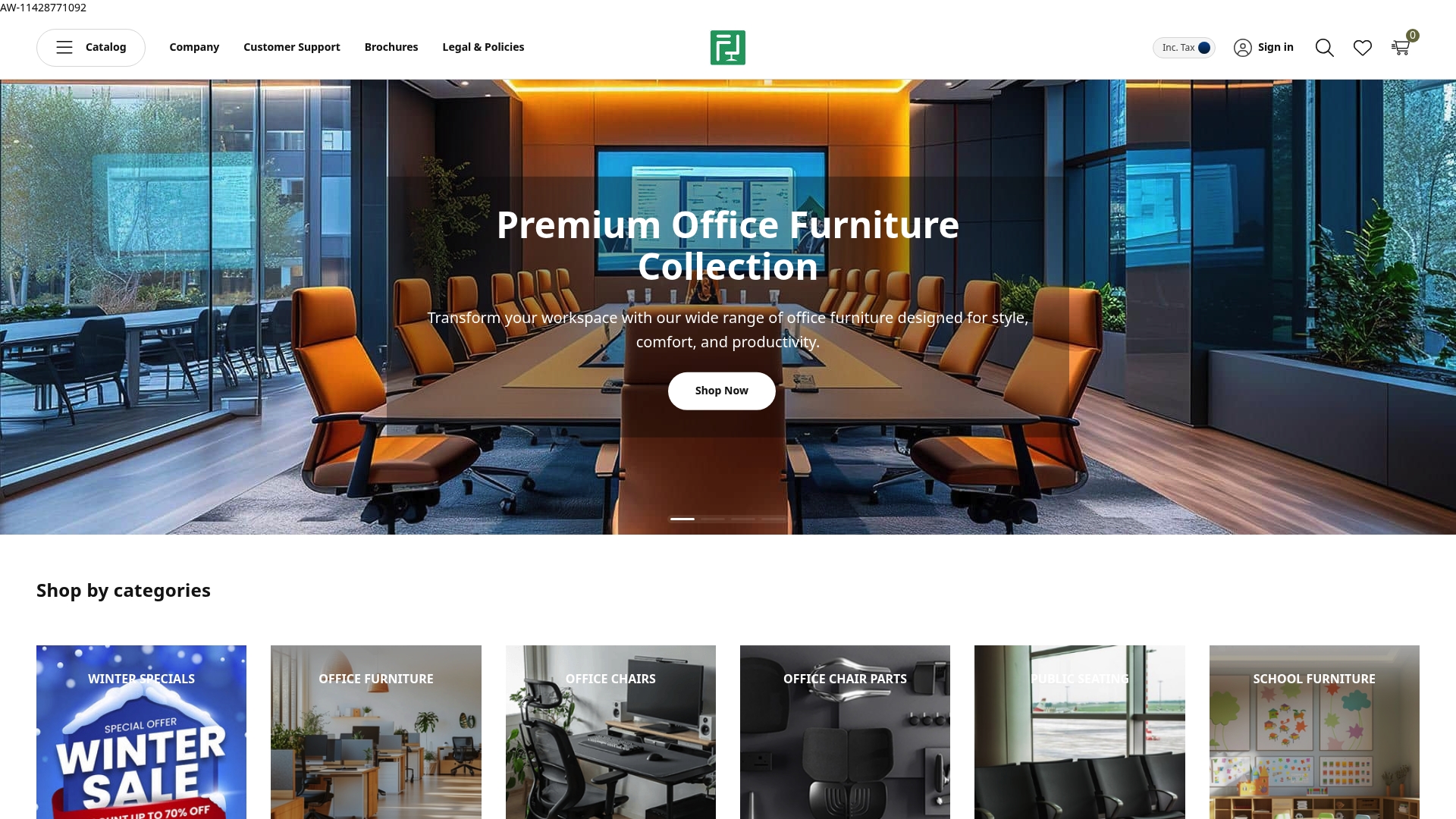Choosing Boardroom Tables in South Africa: 2025 Guide
2nd Jul 2025
Choosing Boardroom Tables in South Africa: 2025 Guide

Boardroom tables shape the way South African businesses connect and make decisions. Yet, even with all the choices out there, a surprising number of companies still settle for tables that actually stifle collaboration. Research shows that allocating just 75 to 90 cm of table space per person can transform meeting engagement and comfort. The real difference comes from choosing tables that fit your unique company culture and space, not just filling a room with furniture.
Table of Contents
- Key Factors When Choosing Boardroom Tables
- Popular Table Styles For Different Sectors
- Sizing And Layout Tips For Your Space
- Sourcing Quality Tables In Southern Africa
Quick Summary
| Takeaway | Explanation |
|---|---|
| Spatial Dynamics Matter | Accurate measurement of room dimensions and table configurations is essential to facilitate comfortable interactions and optimized seating arrangements in boardrooms. |
| Material Selection Reflects Culture | Choosing materials like wood, glass, or metal should align with your brand identity while also considering durability for high-traffic environments. |
| Technology Integration is Crucial | Tables must support modern technology needs, including built-in power outlets and versatile configurations to enhance meeting efficiency and collaboration. |
| Adaptable Designs for Flexibility | Modular and adjustable tables accommodate various meeting formats and future team expansions, promoting a dynamic workplace environment. |
| Sourcing Quality is Essential | Effective procurement involves evaluating suppliers based on quality standards, local manufacturing advantages, and strategies that ensure sustainability and ethical practices. |
Key Factors When Choosing Boardroom Tables
Choosing the right boardroom table requires strategic consideration of multiple aspects that impact functionality, aesthetics, and workplace dynamics. The selection process goes beyond simple measurements and involves understanding how the table contributes to communication, collaboration, and professional image.

Spatial Dynamics and Table Configuration
Board rooms are dynamic environments where spatial planning plays a critical role in table selection. According to workplace design experts at SADECO, room dimensions directly influence table selection. Professionals must meticulously measure available space, ensuring adequate clearance for chair movement and comfortable seating arrangements.
Table shape significantly impacts interaction patterns. Rectangular tables traditionally support hierarchical communication models, with leadership positioned at the head. Conversely, round or oval configurations promote more egalitarian discussions, enabling participants to engage more openly. Seating capacity becomes another crucial consideration, requiring forward-thinking assessment of current and potential future team sizes.
To help visualise how table shapes and configurations influence communication and seating style, see the table below comparing these factors for rectangular, round/oval, and modular boardroom tables.
| Table Shape/Style | Communication Style | Typical Sector Usage | Special Features |
|---|---|---|---|
| Rectangular | Hierarchical | Corporate, Financial | Clear leadership position, easy integration of technology |
| Round/Oval | Egalitarian | Educational, Government | Promotes inclusion, no head seat |
| Modular/Configurable | Flexible/Adaptable | Corporate, Financial, Creative | Supports rapid reconfiguration, expansion options |
| Glass/Composite | Egalitarian/Modern | Technology, Creative | Contemporary aesthetics, technology integration |
Material Selection and Workplace Aesthetics
Material choice communicates organizational culture and professionalism. Wood remains a classic selection, offering warmth and traditional elegance. Modern workplaces increasingly explore glass and metal combinations that signal contemporary, innovative approaches. Office design research suggests materials should align with brand identity and existing interior design language.
Consider durability alongside aesthetic appeal. High-traffic boardrooms demand resilient surfaces capable of withstanding frequent use. Scratch-resistant finishes, easy-to-clean materials, and structural integrity become paramount. Some organizations opt for modular designs that allow flexible reconfiguration, supporting evolving workplace needs.
Technology Integration and Functional Requirements

Modern boardroom tables must accommodate technological infrastructure. Cable management systems, integrated power outlets, and connectivity ports are no longer luxuries but essential features. According to workplace technology surveys, seamless technology integration enhances meeting efficiency and supports hybrid collaboration models.
Ergonomic considerations extend beyond physical comfort. Table height, surface area, and peripheral space for devices impact participant engagement. Adaptable designs that support various meeting formats - from presentation-style sessions to collaborative workshops - provide maximum organizational flexibility.
Careful boardroom table selection represents an investment in workplace communication and organizational culture. By balancing spatial dynamics, material selection, and technological requirements, businesses create environments that foster productive interactions and reflect professional standards. Learn more about optimizing office spaces to make informed decisions that align with your organizational objectives.
Popular Table Styles for Different Sectors
Boardroom tables represent more than mere furniture they are strategic communication platforms that reflect organizational culture and professional identity. Different sectors in South Africa require unique table styles that align with their specific operational dynamics and aesthetic preferences.
Corporate and Financial Sector Preferences
In the corporate and financial sectors, boardroom tables symbolize authority and precision. Workplace design experts indicate a strong preference for rectangular tables crafted from premium materials like mahogany or walnut. These tables typically feature clean lines, sophisticated finishes, and integrated technology solutions that support high-stakes business discussions.
Financial institutions often select tables with modular capabilities, allowing seamless reconfiguration for various meeting formats. Modular design enables quick transitions between presentations, strategy sessions, and collaborative workshops. Power integration and cable management systems are critical, ensuring smooth technological connectivity for complex financial analyses and remote collaboration.
Educational and Government Institutional Approaches
Educational institutions and government sectors prioritize functionality and adaptability in their boardroom table selections. According to office design research, these sectors frequently opt for round or oval tables that promote inclusive discussions and break traditional hierarchical communication structures.
Government departments often select tables made from locally sourced materials, supporting domestic manufacturing and sustainability initiatives. Durability becomes a primary consideration, with tables designed to withstand frequent use and maintain professional aesthetics over extended periods. Lightweight, movable configurations allow for quick room transformations to accommodate various meeting types and participant groups.
Technology and Creative Industry Innovations
Technology and creative industries embrace more dynamic and unconventional boardroom table designs. Workplace innovation studies reveal a growing trend towards tables that blur traditional boundaries between work surfaces and collaborative spaces. Glass, aluminum, and composite materials dominate these innovative designs, reflecting the sector’s forward-thinking approach.
Creative sectors often incorporate adaptable technology zones within their table designs. These areas seamlessly integrate screens, wireless charging stations, and interactive surfaces that support real-time collaboration. Adjustable height mechanisms and ergonomic considerations reflect the industry’s emphasis on employee comfort and technological fluidity.
The choice of boardroom table extends far beyond aesthetic preferences. It represents a strategic investment in workplace communication, reflecting organizational values and supporting sector-specific operational requirements. Explore our comprehensive guide to selecting the perfect boardroom table to make an informed decision tailored to your organizational needs.
To clarify sector-specific boardroom table trends and priorities, the following table summarises the main preferences for different South African industries.
| Sector | Preferred Table Type | Material Focus | Key Priorities |
|---|---|---|---|
| Corporate/Financial | Rectangular, Modular | Wood (Mahogany/Walnut) | Authority, Technology, Flexibility |
| Educational/Government | Round/Oval, Movable | Locally Sourced Wood | Inclusion, Durability, Sustainability |
| Technology/Creative | Modular, Glass/Metal | Glass, Aluminium, Mixed | Collaboration, Tech Integration, Ergonomics |
Sizing and Layout Tips For Your Space
Effective boardroom design transcends aesthetic considerations, requiring precise spatial planning that optimizes functionality, comfort, and professional communication. Understanding the nuanced relationship between table dimensions, room layout, and organizational requirements ensures a productive meeting environment.
Calculating Optimal Table Dimensions
Precision in table sizing is crucial for creating an effective meeting space. Workplace ergonomics research recommends allocating 75 cm to 90 cm of table space per participant to ensure comfortable interaction and adequate working area. This calculation involves considering not just the number of current team members but potential future growth and meeting configurations.
Table width plays a critical role in functionality. Narrow tables around 90 cm to 120 cm wide facilitate better communication and visual engagement, while wider tables can create physical and psychological barriers. Seating capacity becomes a strategic consideration, balancing current team needs with potential expansion. Some organizations opt for expandable or modular tables that can be reconfigured to accommodate changing group sizes.
Room Layout and Spatial Dynamics
Room layout directly impacts meeting effectiveness. According to office design experts, maintaining at least 120 cm of clearance around the table allows comfortable chair movement and supports accessibility requirements. This spatial buffer prevents claustrophobic environments and enables smooth participant interactions.
Table placement within the room requires careful consideration of architectural elements like windows, doors, and technological infrastructure. Positioning the table to maximize natural light while minimizing glare on presentation screens can significantly enhance meeting comfort and engagement. Some organizations strategically orient tables to create visual focal points or align with specific architectural features.
Technology and Accessibility Integration
Modern boardroom layouts must seamlessly integrate technological requirements. Workplace technology surveys highlight the importance of built-in power outlets, cable management systems, and connectivity ports. These features support hybrid meeting models and ensure smooth technological transitions during presentations and collaborative sessions.
Accessibility remains a critical consideration in boardroom design. Tables should accommodate various user needs, including wheelchair accessibility, adjustable height options, and ergonomic considerations. Flexible design approaches allow organizations to create inclusive spaces that support diverse workforce requirements and promote equitable participation.
Choosing the right boardroom table and layout represents a strategic investment in organizational communication and workplace culture. Careful measurement, thoughtful spatial planning, and technology integration create environments that foster productivity, collaboration, and professional excellence. Discover more about optimizing your meeting spaces to make informed decisions that align with your organizational objectives.
Sourcing Quality Tables in Southern Africa
Sourcing high-quality boardroom tables in Southern Africa requires a strategic approach that balances quality, cost-effectiveness, and local manufacturing capabilities. Businesses must navigate a complex landscape of suppliers, manufacturing standards, and procurement protocols to secure furniture that meets their specific organizational needs.
Local Manufacturing and Procurement Strategies
South African Furniture Initiative research indicates a robust local manufacturing ecosystem supporting office furniture production. Government institutions frequently utilize structured procurement processes to ensure quality and support domestic industries. For instance, South African Revenue Service tenders demonstrate the rigorous selection criteria applied when sourcing office furniture.
Local manufacturers offer significant advantages, including shorter supply chains, faster customization, and alignment with regional economic development goals. Sustainable sourcing has become a critical consideration, with many organizations prioritizing suppliers who demonstrate environmental responsibility and ethical manufacturing practices.
Quality Assessment and Supplier Evaluation
Effective boardroom table sourcing requires comprehensive supplier evaluation. According to workplace procurement experts, businesses should assess potential suppliers across multiple dimensions. Key evaluation criteria include manufacturing capabilities, material quality, technological integration, customization options, and after-sales support.
Regional suppliers must meet stringent quality standards. This involves examining wood sourcing practices, manufacturing techniques, finish durability, and compliance with local and international workplace furniture regulations. Some organizations conduct on-site factory audits to verify manufacturing processes and ensure alignment with their quality expectations.
Regional and Cross-Border Procurement Considerations
Southern African procurement research highlights the complexity of furniture sourcing across regional boundaries. While local manufacturers offer significant advantages, businesses also explore cross-border options to access specialized designs or competitive pricing.
Cross-border procurement requires careful navigation of import regulations, transportation logistics, and potential currency fluctuations. Strategic sourcing involves balancing cost considerations with quality assurance, potentially combining local and international suppliers to optimize procurement outcomes.
Selecting the right boardroom table represents a nuanced decision that extends beyond simple product selection. It requires understanding local manufacturing capabilities, quality assessment protocols, and strategic procurement approaches. Explore our comprehensive guide to boardroom furniture procurement to make informed decisions that align with your organizational objectives and support regional economic development.
Frequently Asked Questions
What factors should I consider when choosing a boardroom table in South Africa?
When selecting a boardroom table, consider spatial dynamics, material selection, technology integration, and the adaptability of designs to suit your company’s culture and aesthetic needs.
How much table space do I need per person in a boardroom?
Research suggests allocating 75 to 90 cm of table space per person to enhance comfort and engagement during meetings.
What are the popular styles of boardroom tables for different sectors?
Corporate and financial sectors prefer rectangular, premium wood tables, while educational and government institutions often opt for round or oval tables. Creative industries lean towards modular and innovative designs that support collaboration.
How can I ensure the quality of the boardroom table I purchase?
Evaluate potential suppliers based on their manufacturing capabilities, material quality, customization options, and alignment with sustainability practices to ensure you select a high-quality boardroom table.
Ready to Elevate Your Boardroom Experience?
Are you tired of boardroom tables that cramp your team and hold back true collaboration? This guide uncovered how the right table can transform meetings by matching your space, company culture and technology needs. At Office Stock, we know the struggle of finding furniture that actually improves communication. Poor choices can stall productivity and even send the wrong message to important clients.

Stop settling for generic solutions. Browse Office Stock’s wide selection of boardroom furniture and experience tools designed for modern South African businesses. Every detail, from material durability to tech integration, is covered. Take the next step and create a meeting space where your team feels valued and conversations lead to action. Visit our main site now and let your boardroom reflect your professional ambitions.
Recommended
- Frameless Glass Board White | Buy Office Accessories Online - Office Stock
- Double School Desk in Saligna Wood 1000mm Wide | Buy School Furniture Online - Office Stock
- Durban Sofa Double Seater | Buy Hospitality Furniture Online - Office Stock
- Leather In Room Directory Folder | Buy Uncategorized Online - Office Stock
- Adhesive Pin Board (No Frame - 450*300mm - Black) | Buy Adhesive Pinning Boards Online - Office Stock
- Rectangular Fibreglass Table | Buy Uncategorized Online - Office Stock
